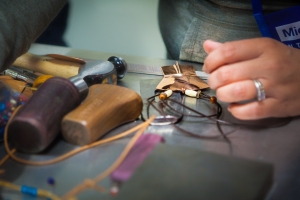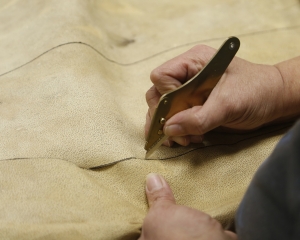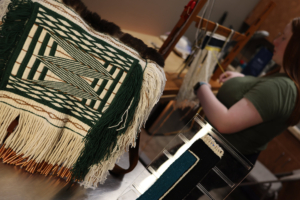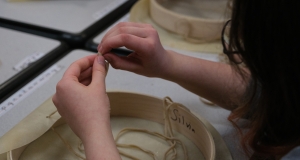Northwest Coast Art and the Future Ahead
At Sealaska Heritage Institute, we are dedicated to preserving and promoting the traditional Native art of the Tlingit, Haida, and Tsimshian peoples. Through workshops, exhibitions, and art programs, we aim to make Juneau the global hub for Northwest Coast art. Guided by our Native Artists Committee, we strive to reclaim and celebrate the rich artistic heritage of Southeast Alaska, supporting both traditional and contemporary artists.
Explore our efforts to honor the creative legacy of our ancestors and keep these vibrant cultural traditions thriving for future generations.
NWC Art Classes
Sewing
Weaving
Metals

Intermediate Metals: Silver Jewelry
June 20-29
Juneau intermediate level silver engraving class.
Carving

Beginning NWC Wood Carving: Paddles & Spoons
June 15-24
Juneau beginning level Norwest Coast carving class on how to make paddles and spoons.
Formline Design
Drum Making
Business Basics for Artists
NWC Certificate of Merit
The Sealaska Heritage Institute is planning to launch a Certificate of Merit, a structured curriculum meant to help NWC Artists hone their skills in specific art tracks. This program will be a tremendous aid to artists looking to build a business or refine an existing one based on their art.
Sealaska Heritage Atnané Hít (Arts Campus)
The indigenous people of Southeast Alaska say they have lived here since “time immemorial.” Their oral histories tell of advancing glaciers that subsumed their land and of retreating glaciers that made way for bays. In recent years, DNA evidence has proven Native people were here at least 10,000 years ago.
The Tlingit, Haida and Tsimshian were ingenius in their use of the resources around them. They built the massive clan houses that once populated the shores of Southeast Alaska using only adzes. They learned to carve and adorn the monumental totem poles that depict ancient histories. Tapping the abundant forests of the region, they carved masks, bowls, boxes, fishing gear, and headdresses and made baskets woven tight enough to hold water. They pioneered ocean-going dugout canoes, which, through a complex steaming process, could be made wider than the girth of the trees from which they came. The indigenous people of Southeast Alaska developed weaving techniques using mountain goat hair and cedar that yielded intricate Ravenstail and Chilkat robes, one of which can take years to complete.
Although historically the Tlingit, Haida and Tsimshian had no term for “art, ” their material culture has come to be known as Northwest Coast art. Northwest Coast art is unique in the world, distinctive for its formline design, a term that describes the shapes, such as split Us and ovoids, and complex arrangements of them that are organized into balanced compositions. One could spend a lifetime mastering the rules governing the formline designs that make the material culture of the Tlingit, Haida, and Tsimshian so unique. Historically, Native people incorporated formline design into almost everything, including clan houses, totems, ceremonial pieces, regalia, and even utilitarian items, such as spoons and dishes. The oldest object ever found depicting formline design dates to 4,000 years ago.
Northwest Coast art was panned as sinful iconography by missionaries who came to Alaska to stamp out Native cultures. Yet, it was zealously and sometimes unscrupulously collected by people from around the world, who often appropriated objects from grave sites. As a Tlingit traditional scholar once put it, “They collected our sins.”
There was a time when the knowledge of how to make Northwest Coast was almost lost, and even today, some ancient art practices, including Chilkat weaving, spruce-root weaving, and canoe carving, are considered endangered. But a handful of dedicated artists and teachers have revived Northwest Coast art and today many of these ancient art practices have been passed on.
We have a dream to make Juneau the Northwest Coast art capital of the world and to designate our ancestors’ legacy as a national treasure. Sealaska Heritage is committed to maintaining the integrity of Northwest Coast art, and the Sealaska Heritage Arts Campus will be an expansion of that effort.
The department includes a director, one Arts Campus/program associate, one program manager, four project staff/coordinators, one Arts Campus receptionist/arts project assistant, and a part-time Arts Campus instructor, to be expanded to two part time instructors. The department works closely with the other SHI departments, especially the Archives and Collections Department in its implementation of artist residencies, arts and museum internships, performing arts programming, the Juried Art Show, and the Youth Art Exhibit; and with the Education Department in its development of educational resources, management of educational platforms, and streamlining of program protocols and processes. Partnering organizations and contractors play a major role in arts programming.
The Native Artist Committee, which is comprised of six master artists, serves as the advisory board for the overall direction of the arts programs.
Sealaska Heritage Institute (SHI) is fundraising for the second phase of its vision to make Juneau the Northwest Coast arts capital of the world and to designate Northwest Coast art a national treasure.
In phase two, SHI will build its Sealaska Heritage Arts Campus in Juneau at Front and Seward Streets, an area designated as Heritage Square by the City and Borough of Juneau in 2018. The space, currently a private parking lot, is directly across the street from SHI’s Walter Soboleff Building, which was built during phase one and opened in 2015. Sealaska donated the parking lot to SHI in 2019 and, through the project, parking will move underground, opening a new cultural space for Juneau residents and visitors at a prime location in downtown. The campus will comprise SHI’s second Box of Knowledge in Juneau.
The campus, which will encompass approximately 6,000 square feet, will house indoor and outdoor space for artists to make monumental Northwest Coast art pieces, such as totem poles and canoes; classrooms for art programming and instruction in areas such as basketry and textile weaving and print making; and space for performances, Native art markets, an art library, artists-in-residence, faculty, and public gatherings. Instruction will be offered for both non-credit and credit for students seeking art degrees through SHI partners, the University of Alaska Southeast and the Institute of American Indian Arts. It will also have capabilities for distance learning.
The overall design will incorporate the same traditional and contemporary themes as in the Walter Soboleff Building with art adorning the facility. The campus will include a totem pole and five monumental bronze masks representing Alaska’s major cultural groups called “Faces of Alaska.” The street and plaza will also include artistic designs tying them to Heritage Square.
SHI’s goals for the campus are to expand Alaska Native and Northwest Coast art programming to ensure perpetuation of these ancient art practices, which are unique in the world and include some practices that are endangered; support Native artists through art markets and classes; and to offer a space where the general public can learn about Alaska Native cultures and art forms at a preeminent space in downtown.
Benefits to Juneau and Beyond
(Juneau Benefits) The Sealaska Heritage Arts Campus will:
- Offer a new cultural experience and gathering space for the public and tourists adjacent to the area named Heritage Square by the City and Borough of Juneau in 2018.
- Help to revitalize downtown, which is a priority of the CBJ.
- Help to implement the Juneau Economic Development Council’s Southeast Alaska Cluster Economic Plan, which emphasizes diversification of Juneau through enhanced visitor experiences with emphasis on the arts as an economic driver.
- Grow the demand for arts, which is already a $58 million industry in Southeast Alaska.
- Offer expanded cultural experiences to residents and tourists.
- Fill a need expressed by local leaders for smaller-scale performance and gathering venues (SHI Survey).
- Contribute to creative and sustainable economies for individual artists and Alaska’s rural communities
- Provide and economic boon during construction by:
Arts Programming
(Arts Programming) The Sealaska Heritage Arts Campus will:
- Allow Sealaska Heritage to expand Alaska Native and Northwest Coast art programming through classes and workshops to ensure perpetuation of these ancient art practices, which are unique in the world.
- Advance a plan by Sealaska Heritage, the University of Alaska Southeast and the Institute of American Indian Art in Santa Fe to create a four-year degree in Northwest Coast art by adding new space for classes.
- Allow SHI to develop and offer e-learning courses on Native art through the campus that provide options to earn high school credits, college credits, dual credits for high school and college, and no credits.
- Offer indoor and covered outdoor spaces for artists to make monumental art, such as totem poles and canoes.
- Include a covered outdoor space for expanded Native art markets.
- Help advance SHI’s goal to establish Juneau as the Northwest Coast arts capital of the world.
- Help ensure the survival and enhancement of ancient art forms and practices and their continued evolution.
Economic Impacts on Artists
(Economic Impacts) The Sealaska Heritage Arts Campus will:
- Contribute to creative and sustainable economies for individual artists and Alaska’s rural communities. Since it opened in 2015, the Sealaska Heritage Store has purchased art from well more than 200 artists.
- Grow the demand for arts, which is already a $58 million industry in Southeast Alaska.
- Help create more global demand for Alaska Native and Northwest Coast art by exposing Juneau’s millions of annual cruise visitors to these ancient art forms in a public and interactive space.
- Offer expanded Native art markets to artists in Juneau and beyond.
Educational Opportunities
(Educational Opportunities) The Sealaska Heritage Arts Campus will:
- Allow Sealaska Heritage to expand Alaska Native and Northwest Coast art programming through classes and workshops to ensure perpetuation of these ancient art practices, which are unique in the world.
- Advance a plan by SHI, the University of Alaska Southeast and the Institute of American Indian Art in Santa Fe to create a four-year degree in Northwest Coast Art by adding new space for classes.
- Allow SHI to develop and offer e-learning courses on Native art through the campus that provide options to earn high school credits, college credits, dual credits for high school and college, and no credits.
- Provide a cultural experience for the public and visitors to learn about Alaska Native and Northwest Coast art and cultures and to promote cross-cultural understanding.
Need even more resources than our short list below? Visit our new downloadable resources page.
Opportunities
- Juried Art Show and Competition
- Juried Youth Art Exhibit
- Artist-in-Residence Program
- Workshops
- Sharing Our Box of Treasurers
- Haa Latseen Community Project
- Art Markets
- First Fridays
- Northwest Coast Native Artist Database
- Volunteer
- Other:
Northwest Coast Formline Design Art Kit
- Textbook (To order hardcopy, contact the Sealaska Heritage Store at thestore@sealaska.com or 907.586.9114)
- Flash cards
- Curriculum boards
- Support Materials:
How-To Books
- Tlingit Wood Carving: How to Carve a Tlingit Mask
- Tlingit Wood Carving: How to Carve a Tlingit Hat
- Tlingit Wood Carving: How to Carve a Tlingit Tray
Instructional Videos
SHI videos are posted online on our YouTube channel (here) and on our Vimeo page (here).
- How to digitize formline: Ovoid construction with David R. Boxley using Adobe Illustrator.
- Spruce-root weaving: This how-to video series shows spruce root weaving in practice, from harvesting the roots to weaving and finishing the basket, as well as some time talking with Delores Churchill, a master Haida weaver. This series was created to help revive the endangered art form of spruce root weaving and features several apprentices. The video documentation was gifted to SHI by Linblad Expeditions as a way to give back to the cultures that their clients (tourists) are exposed to.
- Delores Churchill on a basket she donated to SHI
- Weavers Present: The Revival of Northwest Coast Textiles
- Horn spoon carving: These instructional videos on how to make horn spoons were created in an effort to save this endangered Northwest Coast art practice. Horn spoon instructor Steve Brown narrates the videos.
- The making of a traditional, dugout canoe in Sitka, Alaska
- 3-D scan of a dugout canoe
- Formline by Steve Brown: Day 1
- Formline by Steve Brown: Day 2
- Formline: An Evolving Art by Bill Holm
- How to draw an ovoid
- How to draw a salmon-trout head
- How to stretch a sea otter hide
Lecture Videos
SHI videos are posted online on our YouTube channel (here) and on our Vimeo page (here).
- Documenting Tlingit, Haida, and Tsimshian jewelers, 1850-present
- Indigenous Issues in Native Handicrafts and Intellectual Property (part 1)
- The Fertile Environment for Legal Protections of Native Alaskan Handicraft Heritage (part 2)
- Discovering Haida Art: A Personal Journey by Robert Davidson
- Northwest Coast Art Into the Future, a panel discussion
- Art of our Ancestors: Kodiak Island by Perry Eaton
- The Antiquity and Evolution of Northwest Coast Art by Steve Brown
- The Revival of Tsimshian Art by David A. Boxley
Formline: An Evolving Art by Bill Holm - Three Hundred Years of Tlingit Art by Aldona Jonaitis
- Basketry and Alaska Native Art Revival by Delores Churchill
- On the Origins and Diversity of Northern Northwest Coast Headgear by Steve Henrikson
- Tlingit Carver Amos Wallace
- Hoonah Weaving Program
- Southeast Alaska Totem Parks by Emily Moore
- Being Successful is no Accident: The Business of Art by Robert Davidson
- Tlingit Wood Carving Book Series
Art Supplies
- Artificial sinew
- Beaver fur, drum making kits, and more
- Copper, silver, and jewelry products
- Moose and deer leather
- Real sinew
- Red cedar bark
- Regalia kits
- Robe weaving kits
- Robe weaving materials
- Wood carving tools
Research
- SHI Vitality of Northwest Coast Arts Survey
- SHI Survey on Alaska Native Art and Artists
- Q & A with Rosita Worl: When is it okay to use Northwest Coast formline designs and crests? (coming soon)
Legal Information
- Migratory Bird Policy: How it Affects American Indians and Alaska Natives (PDF)
- A Customs Guide to Alaska Native Arts: What International Travelers, Shop Owners and Artisans Need to Know
- Silver Hand Program and Permit Application
- Certified Tribal Artist Certification Application (Brochure)
- News story on federal and state ivory bans
Donor Levels and Benefits
Note: The deadline to have your name permanently engraved at the campus is Nov. 1, 2021; The names of donors who give $25 or more will be included. To make a donation via mail or phone, please submit this form or contact David Russell-Jensen at donations@sealaska.com.
(Donor Benefits) (Naming Opportunities) SHI is raising funds for the project, which will cost an estimated $14 million to construct. We are offering a wide range of donor levels and benefits.
$100,000 — Naakahídi / Náa / Wap Pteex (Clan House) Sponsor
- Verbal recognition at grand opening ceremony.
- Acknowledgment as a Clan House sponsor in grand opening program, SHI’s Facebook, press releases, and on SHI’s website.
- Name permanently engraved as a founding donor at the campus.
- Limited edition Eighth Generation Blanket of Knowledge (Chilkat-style woven blanket).
- Early tours of facility before public opening.
- Acknowledgment on commemorative grand opening poster and in SHI’s annual report.
$25,000 — Gáas’ (House Post) Sponsor
- Verbal recognition at grand opening ceremony.
- Acknowledgment as a House Post sponsor in grand opening program, SHI’s Facebook, press releases, and on SHI’s website.
- Name permanently engraved as a founding donor at the campus.
- Limited edition Eighth Generation Blanket of Knowledge (Chilkat-style woven blanket).
- Early tours of facility before public opening.
- Acknowledgment on commemorative grand opening poster and in SHI’s annual report.
$15,000 — Naksugit (House Front) Sponsor
- Verbal recognition at grand opening ceremony.
- Acknowledgment as a House Front sponsor in grand opening program, SHI’s Facebook, press releases, and on SHI’s website.
- Name permanently engraved as a founding donor at the campus.
- Limited edition Eighth Generation Blanket of Knowledge (Chilkat-style woven blanket).
- Early tours of facility before public opening.
- Acknowledgment on commemorative grand opening poster and in SHI’s annual report.
$10,000 — X‘een (House Screen) Sponsor
- Acknowledgment as a House Screen sponsor in grand opening program, SHI’s Facebook, press releases, and on SHI’s website.
- Name permanently engraved as a founding donor at the campus.
- Limited edition Eighth Generation Blanket of Knowledge (Chilkat-style woven blanket).
- Early tours of facility before public opening.
- Acknowledgment on commemorative grand opening poster and in Sealaska Heritage Institute’s annual report.
$5,000 — Lákt (Bentwood) Box Sponsor
- Acknowledgment as a Bentwood sponsor in grand opening program, SHI’s Facebook, press releases, and on SHI’s website.
- Name permanently engraved as a founding donor at the campus.
- Early tours of facility before public opening.
- Acknowledgment on commemorative grand opening poster and in SHI’s annual report.
$2,500 — Tináa (Copper) Sponsor
- Acknowledgment as a Copper sponsor in grand opening program, SHI’s Facebook, press releases, and on SHI’s website.
- Name permanently engraved as a founding donor at the campus.
- Acknowledgment on commemorative grand opening poster and in SHI’s annual report.
$1,000 — Xáay (Cedar) Sponsor
- Acknowledgment as a Cedar sponsor in grand opening program, SHI’s Facebook, press releases, and on SHI’s website.
- Name permanently engraved as a founding donor at the campus.
- Acknowledgment on commemorative grand opening poster and in SHI’s annual report.
$500 — Shéiyi (Spruce) Sponsor
- Acknowledgment as a Spruce sponsor in grand opening program, SHI’s Facebook, press releases, and on SHI’s website.
- Name permanently engraved as a founding donor at the campus.
- Acknowledgment on commemorative grand opening poster and in SHI’s annual report.
$250 — Yán (Hemlock) Sponsor
- Acknowledgment as a Hemlock sponsor in grand opening program, SHI’s Facebook, press releases, and on SHI’s website.
- Name permanently engraved as a founding donor at the campus.
- Acknowledgment on commemorative grand opening poster and in SHI’s annual report.
$1-$249 — Xút’aa (Adze)
Sponsor
- Acknowledgment as a Adze sponsor on SHI’s website.
- Acknowledgment in SHI’s Annual Report.
- Donate $25 or more: Name permanently engraved as a founding donor at the campus.
- Donate $50 or more: Additional acknowledgement as an Adze sponsor on SHI’s Facebook and website.
- Donate $100 or more: Additional acknowledgement as an Adze Sponsor in grand opening program
Come build with us.


